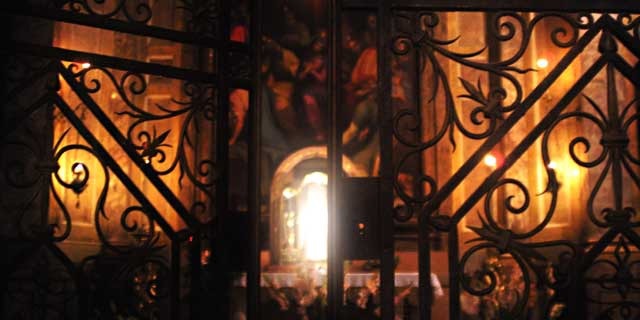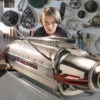
Rough Waters
Written by Andrea Maxwell | Posted by: Anonymous
In 1999, Mary Healey-Conlon began research on a scandal in the Catholic Church. Five years later, Conlon has completed a documentary on one of the most important events in the history of the Church. "Holy Water-Gate" examines the victims and cover-up of the Church’s sexual abuse charges.
"I think many documentary filmmakers realize that as they immerse themselves in a story they are changed by the events and people they encounter," Conlon says. "This is certainly true for me, and I am really proud of the work. The effect that the film has had on me as an individual is an extremely positive one."
Mary Healey-Conlon graduated from Rhode Island College. She pursued her masters at Emerson College shooting and editing projects through 1994. The next few years were focused on corporate clients with artists’ work in the mix, finally allowing her to become an Associate Producer and Producer at Olive Jar Animation in Boston. Continuing to build her corporate and multimedia clientele through documentaries, commercials, and music videos, Conlon now teaches documentary courses at the University of Rhode Island as a professor of communications and film studies.
"All of this varied experience certainly is helpful because all of it helps you anticipate, plan, and most importantly helps you to trust your instincts," she says. Conlon is now in pre-production on her next film "Love- The Rebel, Love- The Tyrant," which explores the idea that humans are made to be coupled only long enough to raise children.
"Holy Water-Gate" will be presented at the Coolidge Theater in Boston on January 10 at 7:30 as part of their New Directors Series. A Q&A will take place after the film with Conlon, co-producer Louise Rosen, and Father Tom Doyle who has been instrumental in working through the sexual abuse problem since he co-authored a report to the US Bishops’ Conference in 1985. They will discuss the film, the impact on the church, and the role of journalists who helped to uncover the scandal, to whom Conlon gives a great deal of credit.
In a recent interview with NewEnglandFilm.com, Healey-Conlon talked about her latest film and her history.
Andrea Maxwell: How did you decide to do this film?
Mary Healey-Conlon: In 1999 I decided to make the film when I realized that victims I came to know were simply not believed by many in press and the public. I was raised Catholic, and my grandfather was a deacon in the Church. He served with a priest by the name of Father Silva, who I knew as a child. After college I began working as a legal assistant and continued doing that work while teaching and running my production company. It turned out that Fr. Silva was accused of abuse in the lawsuits I was working on. It was shocking to me. Bishop Gelineau told the family of the victim, and my grandfather that Fr. Silva wouldn¹t serve in a ministry with children again. Despite this promise, Silva was transferred to numerous other parishes throughout the state where he perpetrated more abuse against children. That is where the film begins. It then quickly moves into other survivors’ stories as well as stories of other key figures in the crisis, including a perpetrator priest (Fr. William), Fr. Tom Doyle and Francis Cardinal George of Chicago. The film also threads the story of how the media grappled with the issue at various points from 1985 to 2004. Clearly, media scrutiny has had a tremendous impact on reporting of cases and also uncovering massive information concerning the depth and breadth of the crisis. I felt very strongly that including some examination of the media’s role was important to understanding the larger issues of the film.
AM: What do you hope to accomplish with this film and with the medium in general?
MC: I hope the film helps people reflect upon the survivors’ stories, the story of Fr. Tom Doyle, the story of the perpetrator priest (Fr. William) and the comments of Cardinal George. I hope the audience will gain insights as to how this crisis happened and what enabled it to continue for so long. As you read any newspaper in any given week, you can see it is still continuing. Most importantly, I hope that people really learn from the stories of the survivors and the perpetrator as to the characteristic behaviors of a perpetrator. The psychological dimension of how a perpetrator grooms his victims is presented through several survivors’ stories. If this knowledge helps someone to keep a child safe and a perpetrator away from children, that’s a tremendous accomplishment. I hope that all survivors and their families (whether or not they are clergy abuse survivors) might find a measure of comfort or a measure of hope from the survivors in the film.
As to what I’d like to accomplish with the medium in general: I wholeheartedly believe that as Author/Filmmaker Mike Rabiger says, documentary films should be a tool for social change. That the insights and the experience you gain watching a well-made documentary film can really transform the way you see your corner of the world. Films like "Dark Days" by Mark Singer, or "Color Adjustment" by Marlin Riggs — those films really do what documentaries should do: they promote introspection, thoughtful discussion, and encourage us to re-examine our assumptions about the subjects of their films. They are not caricatures or simplifications of people or events; rather they complexify and deepen our understandings of events.
AM: What responsibilities do you feel you have as filmmaker?
MC: My greatest responsibility as a filmmaker is to treat a subject with fairness, to treat the audience with intelligence and allow them to draw their own conclusions. That means my obligation and duty, as a documentary filmmaker is also to be a good journalist, and to seek and report the truth. In keeping with that, I felt it was important to communicate to the audience that I did come to the story with a particular point-of-view. They can evaluate that point of view and place it into whatever context they feel necessary when watching the film.
AM: Do you portray a specific position on the issues?
MC: Yes, the film does have a specific point of view: the church used all means necessary to keep this nightmare under wraps. They used their power and prestige to keep the depth of the problem secret. They used their influence with law enforcement to keep victims and their families from prosecuting cases. Almost as a matter of policy (whether written or not) they would promise victims and their families that perpetrators would be isolated and kept away from kids, but instead Bishops would place these men in new parishes to work with a new set of unsuspecting children. This is exactly what happened with Fr. Silva (RI), Fr. William (IL) , Fr. Leifeld (WI), Fr. Hanley (NJ), Fr. Aramito (NY/NJ), and Fr. Warren (OH). All these men are subjects of the film. I didn¹t intend to tell the larger tale of the abuse crisis. But when The Boston Globe story broke in 2002 and an international chain reaction took place, I knew the scope of film was going to be larger than what I originally planned. I originally thought I was going to make a specifically Rhode Island-focused film. There are so many people affected here.
According to the Diocese of Providence’s own numbers, there are over 50 priests and one nun accused of abuse. While I was filming, there were 39 cases before the RI courts. Rhode Island is the smallest yet most Catholic State in the country. All of these factors made it a compelling story on its own. But when the coverage began to intensify in 2002 I suspected I had enough background and contacts and deep enough understanding of the subject matter to thoughtfully document events that were emerging in a way that could be significant. The trickiest part of the whole story was that it kept going, moving, shifting. I filmed over 250 hours of footage in Rhode Island, Massachusetts, Illinois, New Jersey, DC, St. Louis, Rome, Perugia, Assisi, Dallas, Virginia. The only resources I had were interns and later Co-Producer and Rep Louise Rosen and Director of Photography Ned Miller. As Louise often joked, I had a tiger by the tail, but I had already such a commitment to the film I never considered stopping. I literally could still be filming as so many significant events have occurred since June 2004.
As to the focus of the film, I specifically wanted to focus on issues relating to the cover-up, the methods and mechanisms the Church used to keep abuse of children hidden. I was able to develop some trusting relationships with survivors and others who were willing to share their struggles and stories on or off film. I made sure to be at many key events that took place from 2002-2004 to make a good document of those proceedings and provide a measure of context for them within the realm of the larger story. I was able to get access to an enormous amount of archival material as well as uncovering court documents related to the perpetrator interviewed in the film. I used these materials for research and/or for narration and some of it is in the film. I was fortunate to get access to some members of the hierarchy. I was able to secure several interviews with Cardinal George of Chicago and follow him over a bit of time and present him in the film.
This film (and teaching at University of Rhode Island full-time) took over my life, and I’m sure like other filmmakers, my personal life suffered. However, I’ve been blessed to have unbelievable support from the "Holy Water-Gate" team (Louise Rosen, Ned Miller and Jeff Hellyer), my family and friends. It is very painful to look at this issue deeply and honestly, and frankly a lot of this was painful and intimidating. I get a lot of inspiration from the courage of individuals I met while making the film their example kept me going when I was exhausted, broke or frustrated.
As to morals, good guys and victims: All of the individuals in the film have endured enormous pain and tragedy. Some are advocates, some leaders; some reflect the pathetic and sad embodiment of human evil. The question for me (and for the audience) is what do you do when you are confronted with this kind of evil? Do you pretend it’s not there, run away, look away? Doing nothing in response to knowledge that someone is being abused is making a decision. Because of the nature of the film that it touches upon spiritual and moral questions, I had to reflect genuinely upon how those questions could be thoughtfully represented in the film. The participants in the film do this, and since I make the edit decisions my hand casts which of those voices articulate those morals.
AM: Do you think the areas of the country (and the world) had any bearing on the reactions to the crimes?
MC: Do you mean reactions by law enforcement, or reactions by parishioners, or reactions of the church? I can speak to some of the common experiences survivors have reported (and this based upon the people I’ve spoken to about how their abuse was handled by the church. I’ve spoken with people from Los Angeles, Boston, Rhode Island, New Jersey, New York, Ohio, Illinois, Wisconsin, Virginia and Missouri.) There would usually be promises by the Diocese of treatment and removal of the perpetrator. One victim was told by a diocese to go to therapy with her perpetrator and the perpetrator never showed up to the sessions. Once victims realized that nothing was being done with their perpetrator to keep them away from children, many filed lawsuits. Frankly, it is the criminal suits or civil lawsuits as they came through the system that really forced the media to take a harder look at the subject. Many of the crimes didn’t get reported because the kids were traumatized, terrorized and threatened by the perpetrator — they were too afraid to tell. It wasn’t until the adult victims really began to realize how much suffering they had endured and were enduring — that the trauma was not just going to go away — often when the adult survivor realized this (as this was told to me by many survivors) that they came forward to try to get help. Some of those survivors have had the strength to advocate on behalf of others. They have done so at great risk.
AM: How important is it as a filmmaker, especially of documentaries, to go into the film already knowing what point you want to convey?
MC: I think you can make educated guesses at what you think your story will be but reality is always more interesting and complex than one’s imagination. Since this was a documentary in part about events that were unfolding, my goal was to bear witness to these events and to try to understand the context of the stories I was coming to understand and then investigate them further. I needed to understand enough of what was going on with the issues to make sure I was getting the right material at the right places and a lot of this was just banking on my instincts about people as well as continually reading and researching, talking to sources and other journalists. I try to pay attention when my brain and guts keep drawing me to a person. I don’t question it, I just trust that sense. As a filmmaker you envision an "essential essence" of the story you may tell, and that "essential essence" is continually evolving — this is the case because 250 hours of tape does not make a story — you may have 5,000 stories to be discovered within those boxes and your job is to discover that essential purpose for your film.
There was an enormous amount of material I captured and it was a challenge to get to a place where I could discern which narrative threads needed to be included in the film and to clearly identify what larger function they served. I really don’t think one can entirely know the "point" going into a film — for me, it is more discovering the essence and meaning of what I was able to capture on tape and how can that essence be most truthfully and powerfully presented in narrative form. Once you’ve done all this documenting, the material reveals things you perhaps were not considering before. Sometimes you realize you wasted days of shooting on material that turns out to take you away from an essential essence of the story. I think you’re discovering that essential essence to the last day of editing. The reason for this is that watching a film is an experience and I always try to consider what people will feel or what questions they will have at any given stage of the experience of the film. This means that every second builds towards that interplay between the film and the audience and their interpreted meaning of the story (which may be different from mine). Of course you have a solid idea of the story going in, try to capture that essential essence as you go along, but this transformative process happens while you’re shooting, again when you’re reviewing the material, and again while you’re editing. These stories get deepened when you dig up great archival material as well.
Louise Rosen, my co-producer and I wrote and re-wrote stacks of proposals regarding the narrative, the approach and the subjects of the film. Research was ongoing to the last day of editing since it is a contemporary and volatile topic. Ned Miller my DP would always have great ideas on location and he’d shoot twenty beautiful shots from 12 different angles and options and suggest ten more. Jeff Hellyer my editor would build a sequence that was more eloquent than what I envisioned on paper. But I would always try to have that essential essence on paper nonetheless — whether that was in the form of a shot list, a locations list, interview questions, narration or paper-edit.
Everyone on the team was involved in raising the bar for this film. So there’s this tremendous interplay of ideas — everyone’s subconscious is working on how to reveal the power of the story all the time. I trust this subconscious process more than I trust anything else. Of course this process can only happen after you’ve done the hard work, but this is where the film takes its own course and reveals itself to you. This story is so powerful; there’s no dramatization or intensification required by the director or editor needed. What was required was an insistence that the visuals drive the "essence of the story" and that the narration be clear enough to support the revelations of the film at the right moments.
I transcribed every cut. I think there were 67 cuts of the film. I live and teach in RI and edited most of this film in Chicago with Jeff Hellyer. I will never edit a film another way. Jeff and I edited from Novemeber ’03 to mid-June ’04. I would teach three days, fly to Chicago and edit for four days. Some months we had two weeks between edits. This was the basic schedule. I cannot express how profoundly important the time away from the Avid was. Jeff is so busy, he didn’t work on the film while I was away which was perfect. It allowed him distance and it allowed me to mentally grind out revisions to structure and collaborate with Louise and Judith & Tricia (two others who assisted with narration). This distance made all the difference because without that distance of time and space you can’t "see" what’s emerging in the film. The only way to look at the film was the VHS cut and the transcript which would get eviscerated and reorganized before I returned to Chicago with a revised paper edit.
AM: What do you think is the biggest advantage to the documentary film as opposed to a fictional film on the same subject?
MC: I think documentary’s function is to enlighten us to others’ experiences in the world — those real people whose real experiences and pain or courage change the balance of things. Documentary filmmakers help us see these experiences and that shifts the balance of things, deepens our awareness and hopefully our capacity for self-reflection. Documentaries present their audiences an opportunity to deepen their understandings. We all walk around with these "constructions" of what we think is reality. Good documentaries shake our "constructs" and allow us to re-examine them. When that happens, you know you’ve watched a powerful film.
AM: What advice do you have for aspiring documentary directors?
MC: Study good documentary films and the writing of those films. Find a topic you’re passionate about and research it. Ask what makes good documentaries you’ve seen effective. Understand what the narrative structures are in those films. There’s a fantastic book by Chris Vogler called "The Writer’s Journey." It’s really helpful for students to understand some universal principles of basic narrative storytelling. While the book is intended for fiction film writers it’s totally applicable to documentary. Even if you only keep some of the suggestions in mind, audiences do expect and need a solid structure to understand your story of the film.
Second is that visuals should drive the film, that the visuals captured are as high a priority as interview sync or narration. While many people shoot all of their own material now, I do think the importance of a gifted shooter or experienced DP is essential to a good film. Every film should somehow have its own visual approach and style. This is something that Louise Rosen always stressed, particularly with foreign audiences in mind (for subtitling and marketability) If you can’t afford to hire a DP, collaborate with one or brainstorm with one about your shoots/locations — offer him or her free help in exchange for brainstorming time. As much as I wanted or had to do a lot of shooting on my own, nothing can compare to a the footage by a DP like Ned Miller who films all the time in varied situations all over the world. He always will shoot with the edit in mind and he also functioned as key collaborator for the visual ideas of the story.
'Holy Water-Gate' is been sold to television networks in Spain, Australia, Switzerland, Canada, and Denmark. French, German, and a number of US stations are also considering broadcast. Tickets to the Coolidge Theatre showing may be purchased online at www.coolidge.org. More about the film can be found at www.holywater-gate.com.












